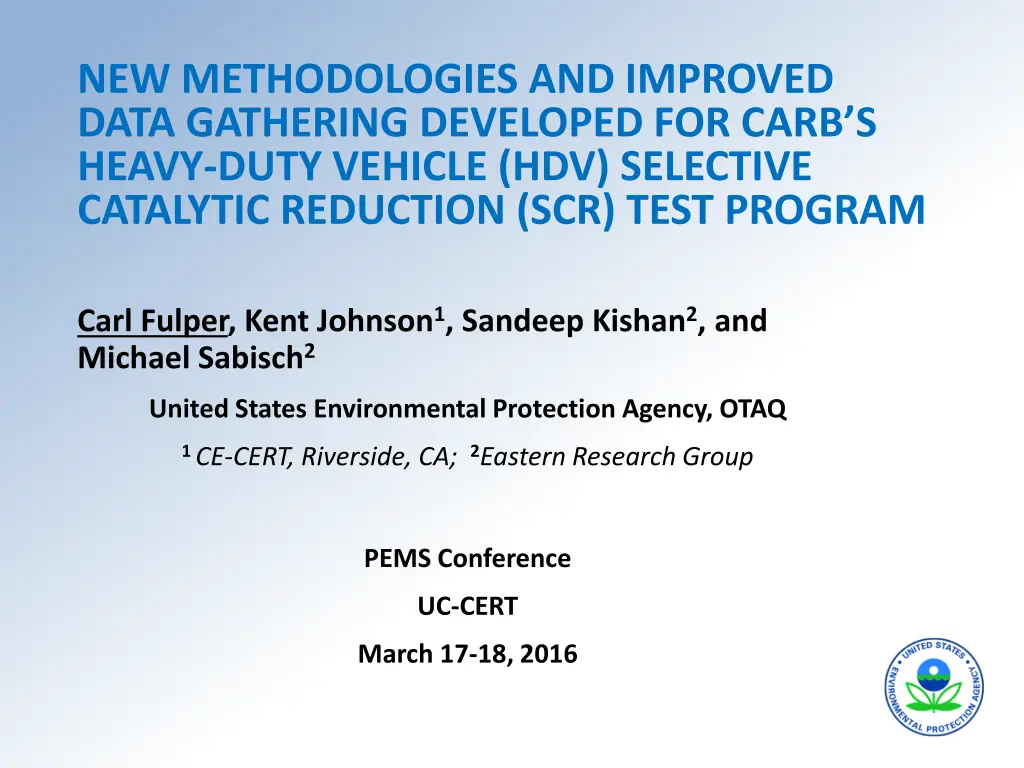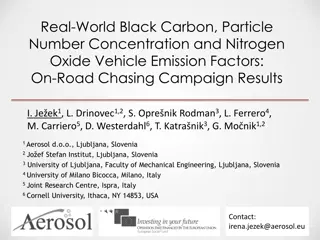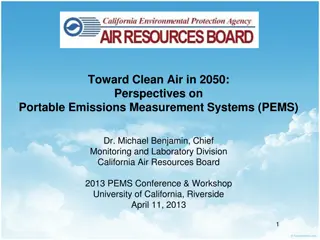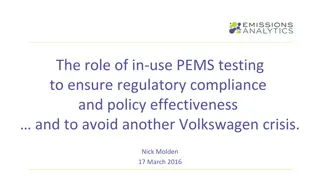
Innovative Strategies for HDV SCR Test Program Enhancement
Discover the latest methodologies and improved data gathering techniques developed for CARB's Heavy-Duty Vehicle (HDV) Selective Catalytic Reduction (SCR) test program. Learn about standardized fleet and vehicle information, integrated real-world testing design, collaborative data gathering efforts, and the objectives of the HDV SCR test program. Explore how partnerships and enhanced support from EPA are driving innovation in emissions testing.
Uploaded on | 3 Views
Download Presentation

Please find below an Image/Link to download the presentation.
The content on the website is provided AS IS for your information and personal use only. It may not be sold, licensed, or shared on other websites without obtaining consent from the author. If you encounter any issues during the download, it is possible that the publisher has removed the file from their server.
You are allowed to download the files provided on this website for personal or commercial use, subject to the condition that they are used lawfully. All files are the property of their respective owners.
The content on the website is provided AS IS for your information and personal use only. It may not be sold, licensed, or shared on other websites without obtaining consent from the author.
E N D
Presentation Transcript
NEW METHODOLOGIES AND IMPROVED DATA GATHERING DEVELOPED FOR CARB S HEAVY-DUTY VEHICLE (HDV) SELECTIVE CATALYTIC REDUCTION (SCR) TEST PROGRAM Carl Fulper, Kent Johnson1, Sandeep Kishan2, and Michael Sabisch2 United States Environmental Protection Agency, OTAQ 1 CE-CERT, Riverside, CA; 2Eastern Research Group PEMS Conference UC-CERT March 17-18, 2016
Outline Introduction of Sampling Methodology Overview of CARB s HDV SCR Test program Enhanced Support for CARB s HDV SCR Test Program Sampling Methodology Standardize Fleet Information Standardize Vehicle Information Data Gathering Data Analysis 2
Integrated Real-World Testing Design CARB/CE-CERT HDV SCR Activity Study - Ongoing 3
Working Together to Gather Data Governments, Universities, Regulated Community, International Regulators, & others Partnerships Testing Laboratory Chassis Dynos Engine Dynos Evap SHEDs Real World PEMS PAMS Remote Sensing 4
Partnerships Partnerships allow for synergies: Combining different experiences and knowledge between partners Better use of facilities and equipment Potential to expand test programs through cost sharing Increase in understanding across the entire emissions community Gain support from local entities 5
CARBs HDV SCR Test Program Features Objective: to develop activity profiles for different types of heavy-duty vehicles CARB contracted with CE-CERT to gather activity data on 100 HD trucks with SCR (MY2010+) Three months of activity data per vehicle Different sizes of vehicles (MDV, HDVs, HHDVs) Different geographic locations within California (North/Central/South) Different truck vocations 6
Enhanced Support from EPA EPA and CE-CERT signed a Cooperative Research And Development Agreement (CRADA) to work together to gather HDV and non-road data EPA and CE-CERT partnered to help support CARB s HDV SCR data gathering effort Technical support Equipment support Sampling Methodology support Data Analysis support 7
Improvements to Sampling Methodology Sampling full fleet instead of just the vehicle being tested with PAMS and/or PEMS Provides a better understanding of how that tested vehicle fits into the rest of the fleet and to the overall vehicle population Developed a new standardized fleet survey form to capture fleet data (details in a later presentation) 8
Improvements to Sampling Methodology Developed new standardized vehicle profile documentation forms (details in a later presentation) Saves field time by taking pictures of vehicle Data fields can be completed later 9
Improvements to Data Gathering Standardizing HDV J1939 Data Files for Loggers (details in a later presentation) Known database structure for quick data analysis Gathering key vehicle parameter fields for present and future data analysis 10
Improvements to Data Gathering Standardizing Data Loggers (Non-cellular) Quicker installation and setup Problem: Did not know if worked for 3 months Cellular Data Loggers (details in a later presentation) Create Dashboard to monitor data logger and vehicle Real-time notification of issues on data logger and/or vehicle and resolve them (better data) Allow Real-time data analysis 11
Improvements to Data Analysis Currently developing and implementing an open database and open data analysis structure with partners Standarddatabase structure: MySQL Standard data analysis and QC/QA techniques: modular designed Scripts in Python and MySQL Standard graphics: R Communicate through Bit-Bucket to share data analysis methods Quicker QA/QC of data Quicker data analysis Quicker Results! 12
Conclusions Partnering together is allowing for: Sharing the experience, knowledge and expertise of staffs; Sharing equipment and costs to gather data; and Better and consistent data to be gathered to address present and future research questions. 13



